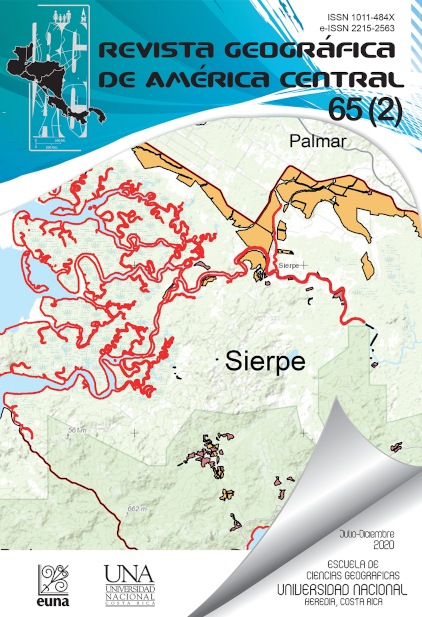Estimation of the surface temperature in Landsat 5 historical images by means of single-channel atmospheric correction in the thermal for the Tempisque-Bebedero river basin (Costa Rica)
DOI:
https://doi.org/10.15359/rgac.65-2.1Keywords:
Remote sensing, Thermal infrared, Emissivity, Surface temperatureAbstract
In recent decades, the use of satellite imagery has increased to the point of being a fundamental tool in the monitoring of environmental processes and global change. In this sense, the historical importance of the Landsat family of satellites marks a milestone in 1985 with the introduction of the Tematic Mapper sensor, which offered users the possibility of acquiring information from an over 25-year historical database of thermal imagery at 120 meters of spatial resolution. This paper is presented as a methodology for obtaining surface temperature data from a time series of Landsat-5 TM images acquired in 2001 on the North Pacific Region of Costa Rica. The different algorithms that can be used for the estimation of surface temperature from Landsat data via the single-channel method by way of the inverse Planck function are presented. Prior to the calculation of the brightness temperature of the images, aspects such as average atmospheric transmissivity, ascending and descending radiance or earth´s surface emissivity were taken into account.
References
Atkins P. & Jones, L. (2006). Principios de Química. Los caminos del descubrimiento. Ed. 5ta). Madrid. España: Médica Panamericana. ISBN: 978-950-06-0080-4.
Barsi J., Barker J. L. & Schott, J. R. (2003). An Atmospheric Correction Parameter Calculator for a Single Thermal Band Earth-Sensing Instrument. International Geoscience and Remote Sensing Symposium (IGARSS). 5. 3014 - 3016 vol.5. 10.1109/IGARSS.2003.1294665.
Barreto, Á., Arbelo, M., Núñez-Casillas, L., Hernández-Leal, P., González-Calvo, A. & Alonso-Benito, A. (2009). Estimación de la emisividad espectral con datos térmicos ASTER de la Isla de Tenerife. IEEE International Geoscience & Remote Sensing Symposium, IGARSS 2009, University of Cape Town, South Africa
Becker, F. & Z.-Li. (1990). Temperature-independent spectral indices in thermal infrared bands, Remote Sens. Environ., 32, 17- 33.
Berk, A., Anderson, G. P., Acharya, P. K., Chetwynd, J. H., Bernstein, L. S., Shettle, E.P., Matthew, M.W. & Adler-Golden, S. M. (1999). MODTRAN 4 user’s manual. Air Force Research Laboratory, Space Vehicles Directorate, Air Force Materiel Command, Hascom AFB, MA.
Carlson, T. & Ripley, D. (1997). On the Relation between NDVI, Fractional Vegetation Cover, and Leaf Area Index. Remote Sensing of Environment. 62. 241-252. 10.1016/S0034-4257(97)00104-1.
Chander, G., Markham, B. L., & Helder, D. L. (2009). Summary of current radiometric calibration coefficients for Landsat MSS, TM, ETM+, and EO-1 ALI sensors. Remote sensing of environment 113: 893-903.
Coll, C., Galve, J., Sánchez-Tomás, J. & Caselles, V. (2010). Validation of Landsat-7/ETM+ Thermal-Band Calibration and Atmospheric Correction with Ground-Based Measurements. Geoscience and Remote Sensing, IEEE Transactions on. 48. 547 - 555. 10.1109/TGRS.2009.2024934.
Denyer, P., Aguilar, T. & Montero, W. (2014). Cartografía geológica de la península de Nicoya. Universidad de Costa Rica.
Gillespie, A. R., (1985). Lithologic mapping of silicate rocks using TIMS, in The TIMS Data Users’ Workshop, JPL Publ., 86-38, 29-44
Gillespie, A. R., Rokugawa, S., Hook, S. J., Matsunaga, T. & Kahle, B. (1999). Temperature/emissivity separation algorithm theoretical basis document, version 2.4. Contract NAS5-31372, Natl. Aeronaut. and Space Admin., Washington, D. C.
Niclòs, R., Estrela M. J., Valiente J. A. & Barberà M. J. (2010). Análisis de correlaciones entre la temperatura del aire y la temperatura de las superficies vegetadas medida con radiometría térmica. Revista de Teledetección, 34: 36-43
Pérez, C. y Muñoz, A.L. (2002). Teledetección: nociones y aplicaciones. Universidad de Salamanca, España.
Prata, J. A. (1994). Land surface temperatures derived from the advanced very high resolution radiometer and the along-0track scanning radiometer: 2. Experimental results and validation of AVHRR algorithms. Journal of Geophysical Research, 99, NO. D6, P. 13,025-13,058.
Quattrochi, D. A., & Luvall, J. C. (2000). Thermal remote sensing in land surface processes. Boca Raton, FL, USA, CRC Press.
Sobrino, J. A., Sobrino, J., Raissouni, N., Kerr, Olioso, López, M. J., Belaid, El-Kharraz, J., Cuenca, J. & Dempere (2000). Teledetección. 10.13140/2.1.2883.3283.
Sobrino, J. & Jiménez-Muñoz, J. C. & Paolini, L. (2004). Land surface temperature retrieval from LANDSAT TM 5. Remote Sensing of Environment. 90. 434-440. 10.1016/j.rse.2004.02.003.
Valor, E. y Caselles, V. (1996). Mapping Land Surface Emissivity from NDVI: Application to European, African, and South American Areas. Remote Sensing of Environment, 57, 167-184.
Downloads
Published
How to Cite
Issue
Section
License
Proposed policy for journals offering Open Access
Authors publishing their works in the Journal acknowledge and agree to the following terms:
a) Authors retain the copyrights to their works and guarantee the Journal the right to be the first to publish their works, under the Creative Commons License Attribution-NonCommercial-ShareAlike 4.0 International, CC BY-NC-SA 4.0 International (https://creativecommons.org/licenses/by-nc-sa/4.0/deed.es), which allows others to share works upon complying with the acknowledgment of authorship and mention of the Journal as the original publisher of the work.
b) Authors are permitted to separately establish additional agreements for the non-exclusive distribution of the official edition of the work published in the Journal (for example, authors may desire to place the work in an institutional repository or incorporate it into a book that is to published elsewhere) so long they acknowledgment to recognize the Journal as the original publisher. The aforementioned additional agreements must respect the terms of the non-profit character and sharing philosophy of the original license (CC BY-NC-SA 4.0 International, https://creativecommons.org/licenses/by-nc-sa/4.0/deed.es).
c) Authors are encouraged to archive the post-print or editor/PDF version in Open Access repositories.






 REVGEO is licensed under https://creativecommons.org/licenses/by-nc-sa/4.0/deed.es
REVGEO is licensed under https://creativecommons.org/licenses/by-nc-sa/4.0/deed.es
.svg_4.png)

_(1).png)
_(1)_(1)_(1)_1.png)
(2)(1)(1)(1).png)
